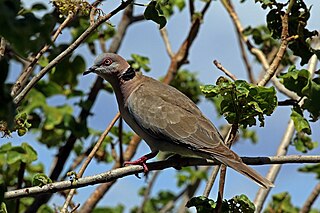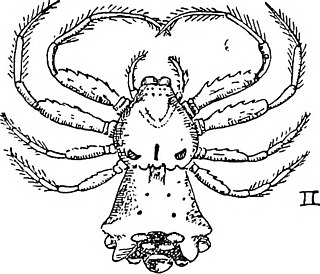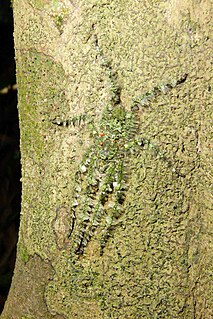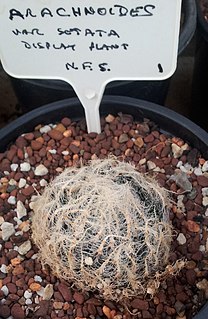
Huntsman spiders, members of the family Sparassidae, are known by this name because of their speed and mode of hunting. They are also called giant crab spiders because of their size and appearance. Larger species sometimes are referred to as wood spiders, because of their preference for woody places. In southern Africa the genus Palystes are known as rain spiders or lizard-eating spiders. Commonly they are confused with baboon spiders from the Mygalomorphae infraorder, which are not closely related.

The mourning collared dove or African mourning dove is a dove which is a widespread resident breeding bird in Africa south of the Sahara. Despite its name, it is not related to the North American mourning dove. This species is common or abundant near water. They often mingle peacefully with other doves.
Henry Ogg Forbes LLD was a Scottish explorer, ornithologist, and botanist. He also described a new species of spider, Thomisus decipiens.
Depreissia is a genus of jumping spiders that was first described by R. de Lessert in 1942. As of June 2019 it contains only two species, found only in the Congo and on Borneo: D. decipiens and D. myrmex.

Synemosyna is a genus of ant mimicking jumping spiders that was first described by Nicholas Marcellus Hentz in 1846.

Yule Island is a small island in Central Province, Papua New Guinea. It is located 160 km NW from Port Moresby, on the south coast of Papua New Guinea.

Serruria, or spiderhead is a genus of flowering plants in the family Proteaceae, endemic to South Africa.

Pandercetes gracilis, also called the lichen huntsman spider and the lichen spider, is a huntsman spider found on New Guinea, the Maluku Islands, Sulawesi, and in Queensland, Australia. Individuals can vary in color and many color forms exist, but unlike squids and certain reptiles, color is fixed at its previous molt. It hunts by hiding among moss and lichen, then ambushing prey that comes into range by pouncing on it.
P. gracilis may refer to:
Halophila decipiens, commonly known as Caribbean seagrass or paddle grass, is a seagrass in the family Hydrocharitaceae. It grows underwater on sandy or muddy sea floors in shallow parts of tropical seas.

Phrynarachne decipiens, the bird-dropping spider, is a species of tropical crab spider from Malaysia, Sumatra and Java. It mimics a bird dropping in its appearance and the way it behaves.

Pandercetes is a genus of huntsman spiders that was first described by Ludwig Carl Christian Koch in his 1875 treatise on Australian spiders. They are mainly distributed in tropical Asia and Australia, and are known for their cryptic coloration that matches local moss and lichen. Their legs have lateral hairs, giving them a feathery appearance, further masking their outline against tree trunks. Their head is somewhat elevated and the carapace has the thoracic region low and flat.

Haworthia arachnoidea, locally known as "papierrosie" (paper-rose) or "spinnekopnes" (spider-nest), is the type species of the genus Haworthia, in the family Asphodelaceae, in the Western Cape Province of South Africa.

Phrynarachne is a genus of crab spiders first described by Tamerlan Thorell in 1869.
Pandercetes plumipes, is a species of spider of the genus Pandercetes. It is native to Ambon Islands, Sri Lanka and New Guinea.
Boliscus decipiens is a species of spiders of the genus Boliscus. It is endemic to Sri Lanka.

Boliscus is a genus of Asian crab spiders first described by Tamerlan Thorell in 1891. As of February 2019 it contains only three species.
Decipiphantes is a monotypic genus of dwarf spiders containing the species Decipiphantes decipiens. It was first described by Michael I. Saaristo & A. V. Tanasevitch in 1996, and has only been found in Belarus, Kazakhstan, Mongolia, and Russia.









